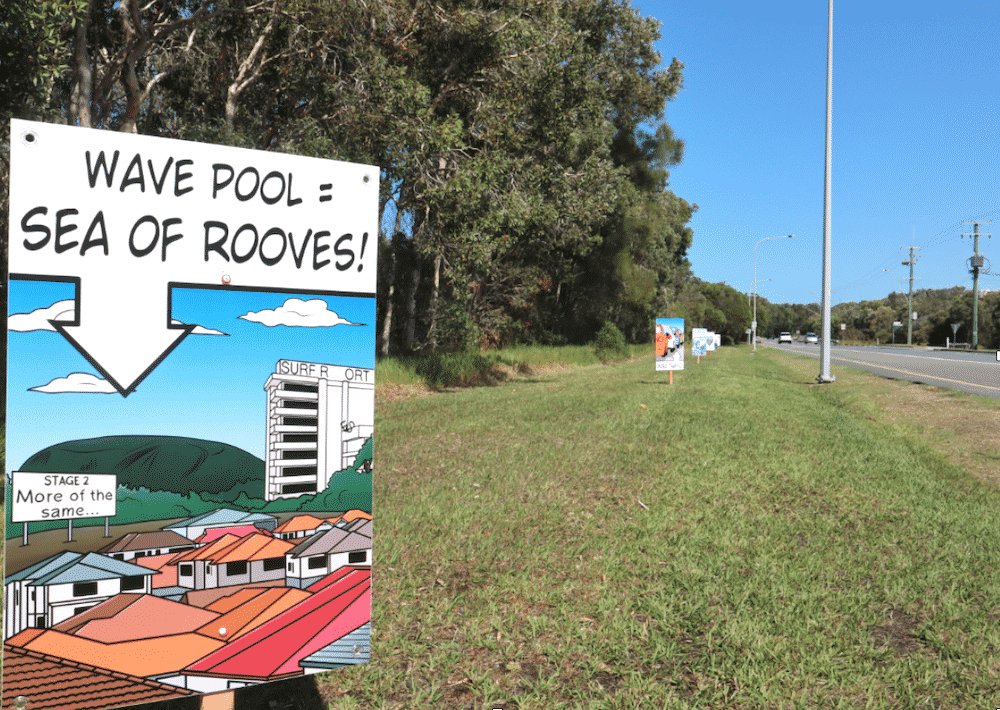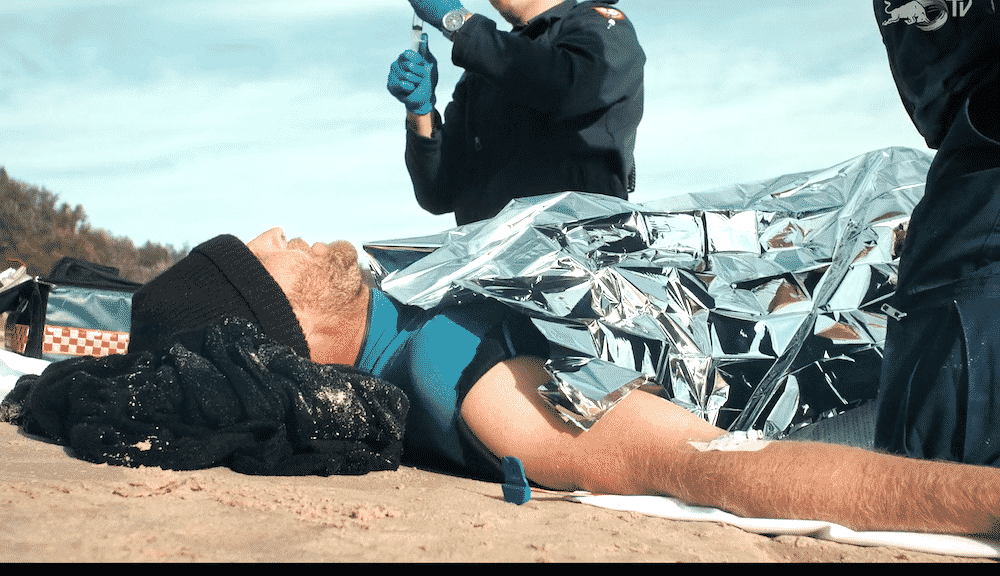Andrew Stark, general manager of the WSL and Kelly Slater Wave Co., said they bare no responsibility for the theft but condemned the signs as providing misinformation…
Last week, two dozen signs protesting the WSL’s proposed billion-dollar pool and “intensive” housing development on a Sunshine Coast flood plain were stolen by agents unknown.
The signs, designed by the non-profit Sunshine Coast Environment Council (SCEC), provided Coolum Beach area citizens information about the environmental impacts of the development omitted by the WSL.
(For background read: Longtom investigates WSL’s billion-dollar wavepool development, parts one and two, here and here.)
The WSL/Consolidated Properties plan features a wavepool, over 1,500 “waterfront homes,” and accompanying urban buildup, all smothering parts of the Maroochy River flood plain; it’s a utopian wonder, really, gently drawing its water demands from the river.
The signs represent a dissenting opinion of the proposal, allowing citizens to consider the proposed construction from an ecological stance.
After all, examining multiple dimensions of a tricky issue is ethical debate 101.
So, if the WSL truly believes the development to be an honest net gain for the area, its citizens and environment, why not welcome these multiple perspectives in good faith?
The development is about improving the lives of Coolum residents, yes?
But trench warfare is a game of inches.
Andrew Stark, general manager of the WSL and Kelly Slater Wave Co., said they bear no responsibility for the theft (and we ain’t suggesting it) but condemned the signs as providing misinformation.
Stark noted an image on the sign depicting a high-rise building among the endless homes, saying the proposed structures were only three-stories tall and would be “no higher than a palm tree.”
A clever use of tropical imagery although palm fronds and slender trunks will become brick and tile behemoths in this new utopia.
The SCEC and its allies are not happy.
I interviewed spokesperson Narelle McCarthy about the proposed development.
Narelle, who stole the signs?
We have our suspicions, however without any evidence we can only say we’re extremely disappointed there are those who appear to want to deny the wider community information and a better understanding of what the project is really about. While there hasn’t been any “open hostility” as such (and nor should there be), there has been relentless lobbying to the Queensland state government by Don O’Rorke of Consolidated Properties (CP) and Andrew Stark of WSL to back this proposal despite its myriad of issues and community objection. Some with vested interests who don’t necessarily fully understand (or care?) about the true nature of the proposal and its impacts have also helped perpetuate the ‘spin.’ It’s even had a ‘COVID recovery’ project tag conveniently attached to it when it would not otherwise be entertained. The irony is that any jobs, let alone the fanciful ten-thousand bandied about for this project would be years away and the touted economic, tourism and community benefits grossly exaggerated.
The WSL has a machine behind them, huh?
A slick PR and marketing campaign ―complete with the ‘consultation’ defaulting to ‘register your support! ― has been deliberately aimed at ensuring only the more superficially ‘attractive’ elements of the proposal are promoted i.e. the ‘Kelly Slater Surf Ranch/Wavepool’. Both O’Rorke and Stark have unashamedly used the ‘Surf Ranch’ as the ‘hook’ when it is in fact a Trojan Horse for intensive urban sprawl onto the critically important Maroochy River floodplain and conflicts with numerous and long-standing statutory planning instruments and intent.
Andrew Stark criticized the signs saying you were spreading disinformation, citing that the proposed buildings were only three-stories high. Is this a dodge from the real issues?
Yes, he does deliberately avoid/dodge the real and significant issues by taking this selective and increasingly convenient tack. It’s also a bit rich given their glossy and selective marketing campaign! The illustration style of the graphic design is intended to convey in an artistic visual ‘snapshot’ how any built form on such low-lying rural land would be a visual assault to residents who enjoy scenic views from the foothills of Mount Coolum and surrounds. Furthermore, any development would totally detract from the natural landscape with its significant indigenous cultural values and the magnificent green open space amenity of this area. It’s subtle, but also a play on the ‘Surf Resort’ with the ‘e’ and‘s’ dropped to send a message about what’s really involved with the overall development i.e. this is not just a ‘wavepool.’ Locals also recognise the likeness to a hotel just down the coast road from Coolum that was built in the early 70’s – the beginning of an era of rampant and unchecked development on the Sunshine Coast.
Have you had any interactions with him or the WSL about the development?
The only contact we have had with Andrew Stark was in a combined community group meeting (the ‘Community 6’ formed after this) over a year ago. Any questions relating to the housing and mixed-use development were batted to Don O’Rorke with Stark primarily keeping to the PR script for the ‘Surf Ranch.’ Their position is that there can’t be a wavepool without the urban component, hardly an attractive or sustainable proposition.
Among numerous unsatisfactory responses and unanswered questions in this one meeting, Stark was asked about the source of the water for the ‘wave pool.’ His response? “From the river, where else would it come from?” as if this was absolutely fine. Apart from being completely unacceptable and as far from an ‘eco-friendly facility’ as it could get, the Maroochy River and its tributaries are ecologically significant and have important recreational and social values. An energy intensive (not even powered by renewables) mechanical pumping system would create major issues and environmental risks when it could be avoided altogether. Why even contemplate urbanizing this floodplain?
Does the development look like a done deal?
While we would have preferred to have had the project unequivocally rejected before now, the state government is now in ‘caretaker mode’ until the Queensland State election on 31 October, so any major decisions can’t be taken. We are calling for the government and any incoming government to rule this project out once and for all. So, we’ll keep up the campaign until this happens. Science and proper process should prevail!






